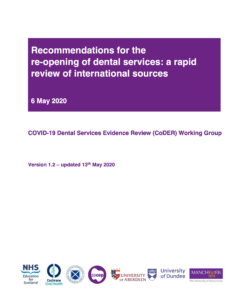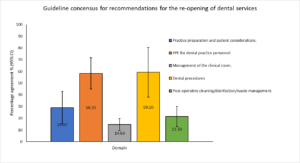
The coronavirus 2 (SARS-CoV-2 [Covid-19]) pandemic has shut, or severely restricted the provision of only but the most essential dental care globally. From the data now currently available we have past the initial peak of infection within the population but it may still take a considerable time to develop a treatment or vaccine for the virus, in the meantime we will have to learn to function with the virus in the community.
The purpose of this rapid review was to scope through the current international guidelines on re-opening dental services to help policy and decision makers establish robust practical evidence-based guidelines.
Methods
Between the 2nd and 6th May a rapid review was conducted of the international guidance for reopening dental services utilising the WHO and the Alliance for Health Policy and Systems Research approach. A grey literature search was undertaken with the assistance of the information scientists at Cochrane Oral Health. Single data extraction was performed and quality was not assessed or validated.
Results
- The review identified 12 guidance documents from 11 countries between the 18th March to the 5th May
- Below are listed the recommendations by domain that were present in >50%:
- Practice preparation and patient considerations
- Patient triage by telephone (92%)
- Social distancing in the waiting area reception (75%)
- PPE for dental practice personnel
- Always wear face mask (67%)
- Unsuspected COVID-19 patients
- Eye protection (100%)
- Unsuspected COVID-19 patients undergoing aerosole generating procedures (AGPs)
- Disposable surgical gown (75%)
- FFP2 mask (67%)
- Surgical hat (50%)
- Confirmed COVID19 patients
- Eye protection, single use of gloves and disposable surgical gown (100%)
- FFP2 mask (75%)
- Surgical hat (67%)
- Confirmed COVID19 patients undergoing AGPs
- FFP2 mask (83%)
- Management of the clinical room
- Clinical room should be kept clear (50%)
- Dental procedures.
- Reduce or avoid AGPs (100%)
- Reduce the risk of transmission (92%)
- Rubber dam and high-volume suction (83%)
- High volume suction (92%)
- Minimally invasive procedures (50%)
- Post-operative cleaning/disinfection/waste management
- Cleaning and disinfection of all surfaces following every patient contact (75%)
- Practice preparation and patient considerations
Conclusions
The authors concluded:-
This rapid review has provided a summary of the international guidance documents published to date. It summarises the main elements of the included documents and highlights several key messages intended to assist policy and decision makers to produce comprehensive national guidance for their own settings. In the majority of the sources addressing specific COVID-19 concerns, there was no referenced, underpinning evidence.
Comments
This rapid review generated a substantial volume of data that can be challenging to interpret. To help develop some context of the balance of information I extracted data both at the domain and subgroup level to produce a summary weight of consensus per domain (See Figure).
What the chart shows us is that there is a high degree of agreement about the clinical aspects of managing individual dental patients, as seen from the PPE and procedures domains, even though there is weak evidence supporting these recommendations. Guidance on how we are going to solve the re-opening problem is significantly weaker (p=0.01) in the domains of practice preparation and patient considerations, management of the clinical room, and post-operative procedures. There is nothing new here in terms of guideline construction as they are generally formulated with very little stakeholder involvement, evidence-base, or applicability (Domains 2,3 and 5 of the AGREE II criteria) (Howe, 2017). The purpose of the review was to identify these weaknesses and address them in the future guideline development.
Links
Primary paper
Recommendations for the re-opening of dental services: a rapid review of international sources
Other references
HOWE, M. S. 2017. What is the methodological quality of published dental implant guidelines? Evid Based Dent, 18, 35-36.


